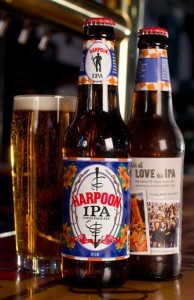
At this point, Rich Doyle — the co-founder of Boston’s Harpoon Brewery — could probably spend an entire day sharing business lessons from the past 27 years in the beer industry.
But at yesterday’s Beer Marketer’s INSIGHTS conference in New York City, Doyle needed less than 30-minutes to provide the 200 or so beer executives in attendance his own “beer insights” — five to be exact.
Doyle, who co-founded Harpoon in 1986 with Daniel Kenary, has helped to grow the company into one of the most successful, regional craft beer companies in the U.S. Harpoon is currently ranked as the country’s 9th largest craft brewery by the Brewers Association, sells its beer in 27 states, and is poised to produce more than 200,000 barrels of beer in 2013.
In the formative stages of Harpoon, Doyle, like any eager entrepreneur, immediately looked for a competitive advantage. For Harpoon, that meant setting up tents and proclaiming to be “the only craft beer brewed and bottled in Boston.”
It wasn’t inaccurate and, when challenged by consumers, Doyle would proudly explain what separated Harpoon from nearby Boston Beer Company, who at the time was producing its beer, under contract, outside of Massachusetts. Looking back, Doyle admits that it wasn’t the right way to gain attention.
“Don’t assume the consumer will care about the same things as you do,” he told attendees. “Simplify your message.”
That was Doyle’s fourth insight, which begs the question, “what were the first three?”
Doyle’s first, is that as a collective industry, beer companies should work to advertise beer for its own qualities instead of trying to compete with spirits occasions.
“I think the beer industry has had a lack of leadership on this subject,” he said. “I think we need to promote beer and not try to imitate spirits.”
And Doyle offered up some pretty creative ideas too. He suggests category-wide campaigns focused on beer-drinking occasions, like Father’s Day, where the beer companies can challenge consumers to “take dad out for a beer.” Or the opening day of baseball season, where companies can ask customers “Doesn’t beer and baseball go well together?”
“Themes like this push us away from spirits,” he said.

“What happens to the brands that aren’t growing so strong in their same states when they run out of states?” he asked. “Are they [new crafts] financing with equity or 3.5 percent bank debt? Will there be price pressures due to over-capacity or closeouts? What do I say to long term wholesalers who say they can’t bring on some new SKU of mine because they just brought on other SKUs from new entrants?”
For Doyle, it is “important to have a sense” of how to answer these questions and his suggestion was to approach each one differently.
For his third insight, the importance of brand differentiation, Doyle took a moment to reflect on Harpoon IPA which is celebrating its 20th anniversary this year.
“We didn’t make it to be popular and maybe that is why it was successful,” he said. “The IPA trend has grown up around us and we have to adjust to that.”
Now that a range of IPAs exist in the craft space, Doyle believes it’s important to “show and demonstrate” what the differences are, but wonders whether differentiation runs the risk of commoditization.
Nonetheless, Doyle said he’s warming up to the idea of “selling the sizzle, not the steak.”
“I am a latecomer to the sizzle,” he said. “I think this discussion is the underpinning for craft versus crafty. Being crafty is as important as crafting a good beer. I used to think that authenticity alone would rule the day. Sizzle really rules.”
For his final insight, Doyle took the opportunity to discuss franchise laws — timely considering that business partner, Kenary, took to Beacon Hill on Tuesday to oppose Massachusetts’ own franchise laws. His message to the distributors in the audience:
“Resistance to carve-outs is a mistake,” he said. “I think a fire break, a small carve out, is much preferred to a forest fire.”
